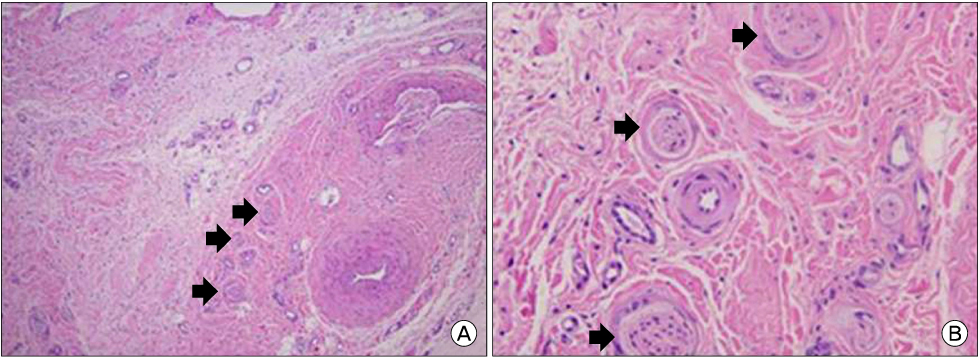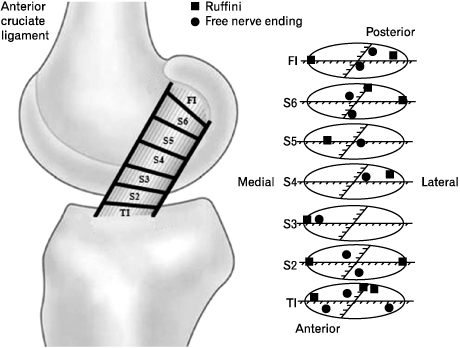Korean J Sports Med.
2012 Dec;30(2):130-136. 10.5763/kjsm.2012.30.2.130.
The Histologic Mapping of Sensory Innervation in the Human Anterior Cruciate Ligament
- Affiliations
-
- 1Department of Nursing School, Chodang University, Muan, Korea.
- 2Department of Orthopaedic Surgery, Wonkwang University School of Medicine, Iksan, Korea. cch@wonkwang.ac.kr
- 3Institute of Wonkwang Medical Science, Iksan, Korea.
- KMID: 2288603
- DOI: http://doi.org/10.5763/kjsm.2012.30.2.130
Abstract
- Recently, rising curiosity on remnant preservation technique of anterior cruciate ligament (ACL) reconstruction, there is much interested in being and distribution of the mechanoreceptor of ACL. So, we performed histologic analyzing and mapping of sensory nerve fiber of the human ACL in this study. Total of 20 anterior cruciate ligaments were obtained from total knee replacement. Each ACL samples was divided into seven specimens; tibial insertion site, mid transitional site, femoral insertion site, and in between the sites, and total of 140 tissue samples were stained with hematoxylin-eosin and immunohistochemical, and observed with light microscope. Five hundred thirty-four fine neuroparticle structures, Ruffini corpuscles, and free nerve endings were observed in 20 ACL samples. The mean of fibers observed were 1.88, 1.71, 1.15, 1.08, 1.15, 1.55, and 1.82, respectively from tibial insertional site to femoral insertional site. With immunohistochemical stain, S-100 protein was strong positive at nerve cells, but was weak positive or negative at neurofilament. Mapping of sensory nerve distribution were done based on the results. We identified the mechanoreceptor of the human ACL using optical and immunohistochemical methods and mapped the histologic distribution of that.
MeSH Terms
Figure
Reference
-
1. Chun CH, Han HJ, Lee BC, Kim DC, Yang JH. Histologic findings of anterior cruciate ligament reconstruction with Achilles allograft. Clin Orthop Relat Res. 2004. (421):273–276.2. Hogervorst T, Brand RA. Mechanoreceptors in joint function. J Bone Joint Surg Am. 1998. 80:1365–1378.3. Ahn JH, Lee YS, Ha HC. Anterior cruciate ligament reconstruction with preservation of remnant bundle using hamstring autograft: technical note. Arch Orthop Trauma Surg. 2009. 129:1011–1015.4. Kim SJ, Jo SB, Kim TW, Chang JH, Choi HS, Oh KS. A modified arthroscopic anterior cruciate ligament double-bundle reconstruction technique with autogenous quadriceps tendon graft: remnant-preserving technique. Arch Orthop Trauma Surg. 2009. 129:403–407.5. Lee BI, Kwon SW, Kim JB, Choi HS, Min KD. Comparison of clinical results according to amount of preserved remnant in arthroscopic anterior cruciate ligament reconstruction using quadrupled hamstring graft. Arthroscopy. 2008. 24:560–568.6. Boyd IA. The histological structure of the receptors in the knee-joint of the cat correlated with their physiological response. J Physiol. 1954. 124:476–488.7. Ekholm J, Eklund G, Skoglund S. On the reflex effects from the knee joint of the cat. Acta Physiol Scand. 1960. 50:167–174.8. Freeman MA, Wyke B. The innervation of the knee joint. An anatomical and histological study in the cat. J Anat. 1967. 101:505–532.9. Burgess PR, Clark FJ. Dorsal column projection of fibres from the cat knee joint. J Physiol. 1969. 203:301–315.10. Marinozzi G, Ferrante F, Gaudio E, Ricci A, Amenta F. Intrinsic innervation of the rat knee joint articular capsule and ligaments. Acta Anat (Basel). 1991. 141:8–14.11. Schultz RA, Miller DC, Kerr CS, Micheli L. Mechanoreceptors in human cruciate ligaments. A histological study. J Bone Joint Surg Am. 1984. 66:1072–1076.12. Song EK, Kim HS, Han HJ, Bae CS, Yoon JR. Innervation of human cruciate ligaments. J Korean Knee Soc. 1992. 4:197–207.13. Zimny ML, Schutte M, Dabezies E. Mechanoreceptors in the human anterior cruciate ligament. Anat Rec. 1986. 214:204–209.14. Katonis P, Papoutsidakis A, Aligizakis A, Tzanakakis G, Kontakis GM, Papagelopoulos PJ. Mechanoreceptors of the posterior cruciate ligament. J Int Med Res. 2008. 36:387–393.15. Chun CH, Lee HS. histologic findings of anterior cruciate ligament reconstructed with bone -patella tendon- bone allograft: prospective study. J Korean Orthop Assoc. 1998. 33:707–713.16. Krauspe R, Schmitz F, Zoller G, Drenckhahn D. Distribution of neurofilament-positive nerve fibres and sensory endings in the human anterior cruciate ligament. Arch Orthop Trauma Surg. 1995. 114:194–198.17. Skinner HB, Barrack RL, Cook SD. Age-related decline in proprioception. Clin Orthop Relat Res. 1984. (184):208–211.18. Pai YC, Rymer WZ, Chang RW, Sharma L. Effect of age and osteoarthritis on knee proprioception. Arthritis Rheum. 1997. 40:2260–2265.19. Bullock-Saxton JE, Wong WJ, Hogan N. The influence of age on weight-bearing joint reposition sense of the knee. Exp Brain Res. 2001. 136:400–406.20. Grigg P, Hoffman AH. Properties of Ruffini afferents revealed by stress analysis of isolated sections of cat knee capsule. J Neurophysiol. 1982. 47:41–54.21. Grigg P, Hoffman AH. Stretch-sensitive afferent neurons in cat knee joint capsule: sensitivity to axial and compression stresses and strains. J Neurophysiol. 1996. 75:1871–1877.22. Messlinger K, Pawlak M, Steinbach H, Trost B, Schmidt RF. A new combination of methods for the localization, identification, and three-dimensional reconstruction of the sensory endings of articular afferents characterized by electrophysiology. Cell Tissue Res. 1995. 281:283–294.23. Clark FJ, Burgess PR. Slowly adapting receptors in cat knee joint: can they signal joint angle? J Neurophysiol. 1975. 38:1448–1463.24. Ochi M, Adachi N, Deie M, Kanaya A. Anterior cruciate ligament augmentation procedure with a 1-incision technique: anteromedial bundle or posterolateral bundle reconstruction. Arthroscopy. 2006. 22:463.e1–463.e5.25. Schutte MJ, Dabezies EJ, Zimny ML, Happel LT. Neural anatomy of the human anterior cruciate ligament. J Bone Joint Surg Am. 1987. 69:243–247.26. Adachi N, Ochi M, Uchio Y, Sumen Y. Anterior cruciate ligament augmentation under arthroscopy. A minimum 2-year follow-up in 40 patients. Arch Orthop Trauma Surg. 2000. 120:128–133.
- Full Text Links
- Actions
-
Cited
- CITED
-
- Close
- Share
- Similar articles
-
- Ligament Reconstruction in Congenital Absence of the Anterior Cruciate Ligament: A Case Report
- Recent Evolution of Cruciate Ligament Surgery of the Knee
- Ganglion Cysts of the Anterior Cruciate Ligament: Three cases report
- Distal Advancement of the Loose Anterior Cruciate Ligament
- Anterior Cruciate Ligament Reconstruction with Achilles Tendon Allograft






